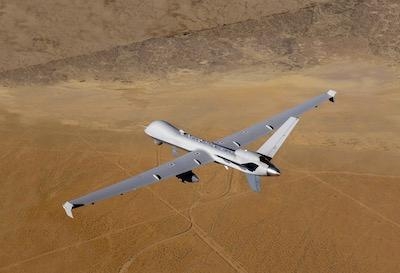Wed, Jan 15, 2020
Brake System Design Also Contributed To The Accident
The U.S. Air Force has released a report stating the cause of an accident involving an MQ-9A Reaper unmanned aircraft which departed a runway at an undisclosed location on September 3, 2018.

According to the report, the Mishap Aircraft (MA) was assigned to the 27th Special Operations Wing (SOW) at Cannon Air Force Base (AFB), New Mexico, and was flown by a Launch and Recovery Element (LRE) crew deployed to the undisclosed location from the 489th Attack Squadron (ATKS), 432nd Operations Group, 432nd Wing, Creech Air Force Base, Nevada.
The Mishap Crew (MC) received an “Engine – metal detected” red warning 10 minutes after takeoff, turned back towards the field and established an orbit to begin fuel dumping. Nine minutes later the engine oil pressure exceeded the limit of 126 pounds per square inch (psi) and the MC received a red warning. Per Aeronautical Systems Incorporated ASI-11114, Flight Manual, the MC elected to make an immediate straight-in landing using engine out procedures due to the possibility of catastrophic engine failure. Upon touchdown the propeller failed to go into reverse and the MA departed the prepared surface; according to Aeronautical Systems Incorporated ASI-11114, Flight Manual, the MQ-9A relies primarily on reverse thrust to slow and stop the aircraft upon landing.
After departing the runway, the MA caught fire and was destroyed with all modifications and four missiles. The resulting loss was valued at $12,726,187. There were no fatalities or damage to private property.
The Abbreviated Accident Investigation Board President found, by the preponderance of the evidence, the cause of the mishap to be the design of the engine. Further, the Board President found, by the preponderance of the evidence, the delay between engine Spectrometer Oil Analysis Program (SOAP) samples being taken and analyzed, as well as the design of the MQ-9A brake system, to be substantially contributing factors.
(Image from file)
More News
Its Offerings Are Lighter, Cleaner, and Now Pushing Past 1,000nm on SAF Jet Fuel DeltaHawk’s diesel-powered aircraft lineup has seen incredible upgrades over the last few yea>[...]
The Airplane Experienced A Total Loss Of Engine Power On December 3, 2025, about 1600 central standard time, a Mooney Aircraft Corp. M20K, N57229, was substantially damaged when it>[...]
Make Sure You NEVER Miss A New Story From Aero-News Network Do you ever feel like you never see posts from a certain person or page on Facebook or Instagram? Here’s how you c>[...]
Aero Linx: European Society of Aerospace Medicine (ESAM) As a pan-European, independent forum, it works to promote the safety and health of all persons involved in aviation and spa>[...]
“We are excited to see Wisk achieve this milestone, and I’m so proud of the team that made it possible. The team at Wisk has built advanced technologies across flight c>[...]
 Aero-TV: DeltaHawks Diesel Power Steps Into the Spotlight
Aero-TV: DeltaHawks Diesel Power Steps Into the Spotlight NTSB Prelim: Mooney Aircraft Corp. M20K
NTSB Prelim: Mooney Aircraft Corp. M20K ANN FAQ: Turn On Post Notifications
ANN FAQ: Turn On Post Notifications ANN's Daily Aero-Linx (12.20.25)
ANN's Daily Aero-Linx (12.20.25) Aero-News: Quote of the Day (12.20.25)
Aero-News: Quote of the Day (12.20.25)



